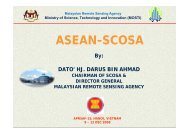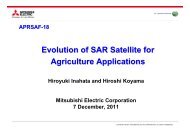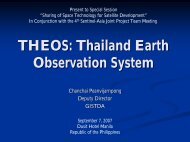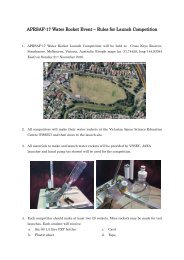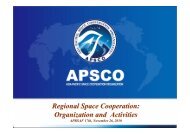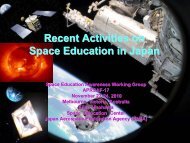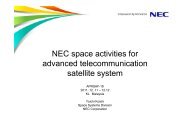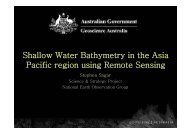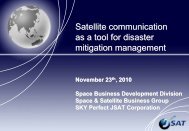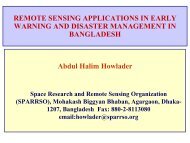MALAYSIA MICROGRAVITY SCIENCES PROGRAMME - - APRSAF
MALAYSIA MICROGRAVITY SCIENCES PROGRAMME - - APRSAF
MALAYSIA MICROGRAVITY SCIENCES PROGRAMME - - APRSAF
Create successful ePaper yourself
Turn your PDF publications into a flip-book with our unique Google optimized e-Paper software.
<strong>MALAYSIA</strong> <strong>MICROGRAVITY</strong> <strong>SCIENCES</strong><br />
<strong>PROGRAMME</strong><br />
‐<br />
COOPERATION BRINGS THE SUCCESS<br />
<strong>APRSAF</strong> ‐18<br />
Singapore<br />
By<br />
Mohd Helmy Hashim<br />
National Space Agency of Malaysia (ANGKASA)
<strong>MALAYSIA</strong> <strong>MICROGRAVITY</strong> <strong>SCIENCES</strong> <strong>PROGRAMME</strong><br />
-<br />
COOPERATION BRINGS THE SUCCESS<br />
CONTENT<br />
1. INTRODUCTION<br />
2. OBJECTIVES OF <strong>MALAYSIA</strong> <strong>MICROGRAVITY</strong> <strong>SCIENCES</strong><br />
<strong>PROGRAMME</strong><br />
3. <strong>MALAYSIA</strong> COOPERATION IN <strong>MICROGRAVITY</strong> <strong>SCIENCES</strong><br />
<strong>PROGRAMME</strong> (2007‐2012)<br />
4. <strong>MALAYSIA</strong> <strong>MICROGRAVITY</strong> PROGRAM 2011 – HIGHLIGHT<br />
5. CONCLUSION<br />
6. PROPOSE OF FUTURE PLANNING/STRATEGIES
<strong>MALAYSIA</strong> <strong>MICROGRAVITY</strong> <strong>SCIENCES</strong> <strong>PROGRAMME</strong><br />
-<br />
COOPERATION BRINGS THE SUCCESS<br />
1.0 INTRODUCTION :<br />
THE MOTIVATION <strong>MALAYSIA</strong> TO INVOLVE IN <strong>MICROGRAVITY</strong><br />
<strong>SCIENCES</strong><br />
‐ BUILDING LOCAL CAPACITY<br />
[enables Malaysia to explore frontiers of education in science, technology and engineering, in<br />
ways never before envisaged by Malaysians. The Program involve scientists, educationists,<br />
general public and students (the next generation of explorers)]<br />
‐ BUILDING LOCAL CAPABILITIES<br />
[basic infrastructure/spacelab/equipment, research mechanism, identified national priority<br />
needs and development goals/outcome) as well as estimate the national readiness]<br />
Through<br />
INTERNATIONAL AND<br />
LOCAL<br />
COOPERATION!!
<strong>MALAYSIA</strong> <strong>MICROGRAVITY</strong> <strong>SCIENCES</strong> <strong>PROGRAMME</strong><br />
-<br />
COOPERATION BRINGS THE SUCCESS<br />
2.0 OBJECTIVES OF <strong>MALAYSIA</strong> <strong>MICROGRAVITY</strong> <strong>PROGRAMME</strong><br />
To inspire the peoples to strive for excellence and a unity of<br />
purpose and all instill a sense of identity that will promote<br />
national resolve and enrich their lives;<br />
Gaining knowledge and experience from other countries and<br />
using this acquisition as a base to expertise in space science and<br />
Microgravity applications;<br />
To send experiments to the space that will benefit to science,<br />
technology and industry;<br />
To instill the interest of the young generation to explore new<br />
areas of science and technology which hare crucial to sustaining a<br />
long‐term national competitiveness in a global era.
<strong>MALAYSIA</strong> <strong>MICROGRAVITY</strong> <strong>SCIENCES</strong> <strong>PROGRAMME</strong><br />
-<br />
COOPERATION BRINGS THE SUCCESS<br />
3.0 <strong>MALAYSIA</strong> COOPERATION IN <strong>MICROGRAVITY</strong> <strong>SCIENCES</strong><br />
<strong>PROGRAMME</strong> (2007‐2012) 2012)<br />
Experience of Malaysia as non ISS Partner on Microgravity Sciences Programme<br />
Malaysia Agriculture Research and<br />
Development Institute (MARDI)<br />
Ministry of Higher Education<br />
(MOHE)<br />
Local Universities –UTM, UMT,<br />
UiTM, UMS, UKM, UniKL, MMU<br />
Local<br />
Ministry of Education (MOE)<br />
Dewan Bahasa dan Pustaka<br />
(Department of Linguistic)<br />
Asian Pacific Regional Space Agency<br />
Forum (<strong>APRSAF</strong>)<br />
United Nation Office for Outer Space<br />
Affairs (UNOOSA)<br />
Japan [trough Japan Aerospace<br />
Exploration Agency (JAXA) ]<br />
Russia trough Russian Federal Space<br />
Agency (ROSCOSMOS) and<br />
Institute of Biomedical Problem<br />
(IBMP)<br />
European Space Agency (ESA)<br />
National Aeronautics and Space<br />
Administration (NASA)<br />
International<br />
Malaysia<br />
Microgravity it<br />
Programme
<strong>MALAYSIA</strong> <strong>MICROGRAVITY</strong> <strong>SCIENCES</strong> <strong>PROGRAMME</strong><br />
-<br />
COOPERATION BRINGS THE SUCCESS<br />
3.0 <strong>MALAYSIA</strong> COOPERATION IN <strong>MICROGRAVITY</strong> <strong>SCIENCES</strong><br />
<strong>PROGRAMME</strong> (2007‐2012)<br />
2012)
<strong>MALAYSIA</strong> <strong>MICROGRAVITY</strong> <strong>SCIENCES</strong> <strong>PROGRAMME</strong><br />
-<br />
COOPERATION BRINGS THE SUCCESS<br />
3.0 <strong>MALAYSIA</strong> COOPERATION IN <strong>MICROGRAVITY</strong> <strong>SCIENCES</strong><br />
<strong>PROGRAMME</strong> (2007‐2012)<br />
1. International Cooperation<br />
Malaysia Astronaut<br />
New Program<br />
Partner<br />
Programme (2007) (Post Malaysia Astronaut Program 2008‐2012)<br />
1. Passive Dosimeter for Life<br />
Science Experiment in Space<br />
1. The Utilization of High Quality Protein Crystal Growth Experiment<br />
onboard ‘KIBO’ (2009‐2012)<br />
(PADLES) 2. Student’s Parabolic Flight Programme (2007)<br />
3. Education and Outreach (2011)<br />
JAXA<br />
(ISS Partner)<br />
1. Life Sciences Experiment in 1. Life Sciences Experiment in MARS500 Isolation Programme (2010‐2012) IBMP<br />
ISS 2. Microgravity Research Program on Biosatellite – BION (2012‐2014)<br />
2014) (non ISS<br />
Partner)<br />
1. Malaysian Astronaut Training<br />
and Launching<br />
ROSCOSMOS<br />
(ISS Partner)<br />
1. Life Sciences Experiment in<br />
ISS<br />
1. Scientific Partners ESA<br />
(ISS Partner)<br />
1. Instrument Fabrication and<br />
Experiment Apparatus<br />
2. Research and Educational<br />
programme on C‐elegans<br />
1. Scientific Partners NASA<br />
(ISS Partner)
<strong>MALAYSIA</strong> <strong>MICROGRAVITY</strong> <strong>SCIENCES</strong> <strong>PROGRAMME</strong><br />
-<br />
COOPERATION BRINGS THE SUCCESS<br />
3.0 <strong>MALAYSIA</strong> COOPERATION IN <strong>MICROGRAVITY</strong> <strong>SCIENCES</strong><br />
<strong>PROGRAMME</strong> (2007‐2012)<br />
1. International Cooperation<br />
Malaysia Astronaut<br />
New Program<br />
Partner<br />
Programme (2007) (Post Malaysia Astronaut Program 2008‐2012)<br />
1. Actively participate 1. Research and Educational Programme in KIBO utilization<br />
2. Student’s Parabolic Flight Programme (2008 – 2011)<br />
3. Space Seeds For Asian Future (2010‐2012)<br />
4. Life communication with Japan Astronaut in ISS (2011)<br />
5. Try your zero‐G (Educational Demonstration Experiment in ISS) by<br />
Japanese Astronaut<br />
<strong>APRSAF</strong><br />
1. United Nations Committee on<br />
the Peaceful Uses of Outer<br />
Space (UNCOPOUS) –<br />
Actively participate<br />
1. United Nations Committee on the Peaceful Uses of Outer Space<br />
(UNCOPOUS) –Actively participate<br />
2. Human Space Technology Initiative (HSTI) –Expert Meeting (2011)<br />
3. Astronaut Public Forum (2011)<br />
UN
<strong>MALAYSIA</strong> <strong>MICROGRAVITY</strong> <strong>SCIENCES</strong> <strong>PROGRAMME</strong><br />
-<br />
COOPERATION BRINGS THE SUCCESS<br />
3.0 <strong>MALAYSIA</strong> COOPERATION IN <strong>MICROGRAVITY</strong> <strong>SCIENCES</strong><br />
<strong>PROGRAMME</strong> (2007‐2012)<br />
2. Local Cooperation<br />
Malaysia Astronaut Programme<br />
New Program<br />
Partner<br />
(2007)<br />
(Post Malaysia Astronaut Program 2008‐2012)<br />
1. Life Video telecast from ISS with<br />
Malaysian Astronaut<br />
2. Life communication i with ih Astronaut<br />
in ISS<br />
3. Research and Educational program<br />
on C‐elegans<br />
1. Space Seeds for Asian Future (2010‐2012)<br />
2. Space Science Educational Module (Teachers Training<br />
Version) (2009)<br />
3. Life communication with Japan Astronaut in ISS (2011)<br />
4. Try your zero‐G (Educational Demonstration<br />
Experiment in ISS) by Japanese Astronaut<br />
MOE, MARDI, MOA ,<br />
Radio and TV station,<br />
Mass media<br />
1. Life Sciences Experiment in ISS<br />
(Cells in Space, Microbes in Space,<br />
Protein in Space, Food In Space)<br />
‐ 1. Encyclopedia on Space Science (including microgravity) Dewan Bahasa dan<br />
Pustaka (Department of<br />
Linguistic)<br />
1. Life Sciences Experiment in MARS500 Isolation<br />
Programme (2010‐2012)<br />
2. The Utilization of High Quality Protein Crystal Growth<br />
Experiment onboard ‘KIBO’<br />
(2009‐2012)<br />
3. Education and Outreach (2011)<br />
4. Human Space Technology Initiative (HSTI) –Expert<br />
Meeting (2011)<br />
5. Astronaut Public Forum (2011)<br />
6. Microgravity Research Program on Biosatellite –BION<br />
(2012‐2014)<br />
Local Universities,<br />
MARDI, Radio and TV<br />
station, Mass media
<strong>MALAYSIA</strong> <strong>MICROGRAVITY</strong> <strong>SCIENCES</strong> <strong>PROGRAMME</strong><br />
-<br />
COOPERATION BRINGS THE SUCCESS<br />
3.0 <strong>MALAYSIA</strong> COOPERATION IN <strong>MICROGRAVITY</strong> <strong>SCIENCES</strong><br />
<strong>PROGRAMME</strong> (2007‐2012)<br />
2012)<br />
2. Local Cooperation<br />
Malaysia Astronaut Programme<br />
(2007)<br />
1. Malaysian Astronaut Training and<br />
Launching<br />
1. Life Sciences Experiment in ISS<br />
(Cells in Space, Microbes in Space,<br />
Protein in Space, Food In Space)<br />
New Program<br />
(Post Malaysia Astronaut Program 2008‐2012)<br />
1. Microgravity Workshop I (2008)<br />
2. Microgravity Workshop II (2009)<br />
3. Special Briefing to Parliamentary Members on Malaysia<br />
Astronaut Mission Microgravity Program<br />
Partner<br />
Local Universities,<br />
Astronautic Technology<br />
Sdn. Bhd (ATSB),<br />
MARDI, Radio and TV<br />
station, Mass media<br />
Local Universities, Mass<br />
Media, Radio and TV<br />
station
Malaysia Experience On Microgravity Sciences through non‐<br />
ISS partner participation p of ISS members<br />
• 1 st National Angkasawan Programme (2007).<br />
PARTNER: ROSCOSMOS, ESA, JAXA, NASA<br />
During the stay onboard the ISS, Malaysian astronaut had implemented five experiments which are two<br />
experiments on “Cells in Space” , two experiments on “Microbes in Space” and one experiment on “Protein<br />
Crystallization Growth”. Besides those five experiments, Malaysian astronaut had also expedited “Food in<br />
Space” survey, “Space Medicine Experiments” and implemented “Education Modules in Space”.<br />
• The Utilization of High Quality Protein Crystal<br />
Growth Experiment Onboard the Japanese Experiment<br />
Module “Kibo”(6 flight from 2009 – 2012) –PARTNER:<br />
JAXA<br />
• Malaysia Space Seed Programme (2010 – 2012) (via<br />
<strong>APRSAF</strong> Regional Collaboration through JAXA)<br />
11
<strong>MALAYSIA</strong> EXPERIENCE ON <strong>MICROGRAVITY</strong><br />
<strong>SCIENCES</strong> through non‐ISS platform<br />
• Parabolic Flight programme (2007‐2012)<br />
3 flight done(4 experiment) and one in 2012 (1 experiment) (via <strong>APRSAF</strong> Regional<br />
Collaboration through JAXA)<br />
• MARS500 programme(2009 ‐2012) on space medicine (2<br />
experiments) *working with IBMP (with is non ISS<br />
partner organization)<br />
Exp 1: Effects of isolated confined environment on brachial artery flow mediated dilation and<br />
brachial pressure index; and<br />
Exp 2: Effects of prolonged dliving in a confined isolation facility on inflammation, endothelial<br />
l<br />
function, oxidative stress and thrombogenesis.<br />
• Bio‐Satellite Programme (2013‐2015)<br />
This project has the objectives of investigating the effects of microgravity environments on<br />
“Bio‐Science Experiments”, “Medical Science Experiments” and “Scientific Agricultural<br />
Experiments” onboard a Russian satellite for the duration of three to six months in orbit.<br />
12
<strong>MALAYSIA</strong> <strong>MICROGRAVITY</strong> <strong>SCIENCES</strong> <strong>PROGRAMME</strong><br />
-<br />
COOPERATION BRINGS THE SUCCESS<br />
4.0 <strong>MALAYSIA</strong> <strong>MICROGRAVITY</strong> PROGRAM 2011 - HIGHLIGHT<br />
Malaysia on it’s planning to be more actively participate in microgravity<br />
programme. A long the year of 2011, Malaysia has been participated and<br />
implemented microgravity programmes as below:<br />
i. Parabolic Flight Program 2011 (PF2011)<br />
‐ Request for Proposal 2011<br />
‐ Outreach Program 2011<br />
‐ Parabolic Flight – Microgravity Awards to the University (for PF2011)<br />
ii.<br />
Education and Outreach<br />
‐ Public talk on Microgravity Sciences<br />
iii. Space seeds For Asian Future (2011)<br />
‐ Update: handing over seeds ceremony and activities<br />
iv.<br />
Protein Crystallization in Kibo<br />
v. Expert Meeting on Human Space Technology Initiative
<strong>MALAYSIA</strong> <strong>MICROGRAVITY</strong> <strong>SCIENCES</strong> <strong>PROGRAMME</strong><br />
-<br />
COOPERATION BRINGS THE SUCCESS<br />
4.0 40<strong>MALAYSIA</strong> <strong>MICROGRAVITY</strong> PROGRAM 2011 – HIGHLIGHT<br />
Parabolic Flight Program 2011 (PF2011)<br />
Progress:<br />
‐ Under Cooperation and platform of <strong>APRSAF</strong><br />
‐ With local cooperation of MOHE<br />
‐ Under the title of award “University Microgravity Science<br />
Research Innovation Programs 2011”<br />
‐ Began on 7 th Feb. 2011 (call for proposal)<br />
‐ Open to all Sciences and Technical universities in Malaysia<br />
‐ Opportunities for undergraduate/postgraduate/ young<br />
researcher students<br />
‐ Open to Physics / Chemist/ Art/ Biologist/ Technical<br />
Engineering fields<br />
‐ Closed on 7 th July 2011
<strong>MALAYSIA</strong> <strong>MICROGRAVITY</strong> <strong>SCIENCES</strong> <strong>PROGRAMME</strong><br />
-<br />
COOPERATION BRINGS THE SUCCESS<br />
4.0 40<strong>MALAYSIA</strong> <strong>MICROGRAVITY</strong> PROGRAM 2011 – HIGHLIGHT<br />
Parabolic Flight Program 2011 (PF2011) (Cont’)<br />
Progress:<br />
‐ One proposal from Kuala Lumpur University<br />
(UniKL) was selected for the PF2011 (scheduled on<br />
Mac 2012 in Nagoya) with the title of research ‘Rate<br />
of Transfer of Moisture From Bath towel to Human<br />
Skin During 1G and Microgravity Conditions –<br />
Hygienic Purposes’<br />
‐ Ceremony of award of “University Microgravity<br />
Science Research Innovation Programs 2011” was<br />
hld held on 15 th October 2011 – officiated by the Deputy<br />
Ministry of Science, Technology and Innovation.<br />
‐ The student team has been ready for the PF2011<br />
The student team has been ready for the PF2011<br />
mission next year.
<strong>MALAYSIA</strong> <strong>MICROGRAVITY</strong> <strong>SCIENCES</strong> <strong>PROGRAMME</strong><br />
-<br />
COOPERATION BRINGS THE SUCCESS<br />
4.0 40<strong>MALAYSIA</strong> <strong>MICROGRAVITY</strong> PROGRAM 2011 ‐ HIGHLIGHT<br />
Parabolic Flight Program 2011 (PF2011) (Cont’)<br />
Progress:<br />
‐ By this year, some innovation was<br />
implemented on the Parabolic<br />
Flight Program.<br />
‐ The students team were supplied<br />
with ihspecial ilcustom made flying sut.<br />
‐ To increase the other students<br />
interest to participate p in this<br />
program;<br />
‐ One of mechanism to promote the<br />
Parabolic Flight Programme.
<strong>MALAYSIA</strong> <strong>MICROGRAVITY</strong> <strong>SCIENCES</strong> <strong>PROGRAMME</strong><br />
-<br />
COOPERATION BRINGS THE SUCCESS<br />
4.0 <strong>MALAYSIA</strong> <strong>MICROGRAVITY</strong> PROGRAM 2011 ‐ HIGHLIGHT<br />
Education and Outreach<br />
‐ Public Talks series on microgravity was held on 10 th to 14 th October 2011 in conjunction of the 4 th<br />
Celebration of Angkasawan (Malaysian Astronaut) Launched to ISS;<br />
‐ Under the theme of “Bringing the Earth to Space” this activity was jointly organized under<br />
ANGKASA‐JAXA cooperation programme under the support of 4 local universities (UTM, UMS,<br />
UniKL and UMT) which covers entire 4 zones of Malaysia;<br />
Date University Location<br />
10 th October 2011 UniKL Central Zone of Peninsular<br />
Malaysia<br />
12 th October 2011 UMT Eastern Zone of Peninsular<br />
Malaysia<br />
13 th October 2011 UTM Southern Zone of Peninsular<br />
Malaysia aaysa<br />
14 th October 2011 UMS Malaysia East (Borneo)
<strong>MALAYSIA</strong> <strong>MICROGRAVITY</strong> <strong>SCIENCES</strong> <strong>PROGRAMME</strong><br />
-<br />
COOPERATION BRINGS THE SUCCESS<br />
4.0 40<strong>MALAYSIA</strong> <strong>MICROGRAVITY</strong> PROGRAM 2011 ‐ HIGHLIGHT<br />
Education and Outreach (Cont’)<br />
- Three experts from JAXA were invited<br />
to deliver their talks on microgravity:-<br />
i. Mr. Shigeki Kamigaichi (KIBO<br />
update, Promotion and Research<br />
Opportunities);<br />
ii. Prof. Dr. Noriaki Ishioka (Research<br />
on Life Sciences under microgravity<br />
it<br />
environment);<br />
iii. Prof. Dr. Takehiko Ishikawa (Research<br />
on Physical Sciences under<br />
microgravity environment);<br />
- One person from ANGKASA was also<br />
involved to deliver his talk on<br />
Microgravity Experiment through<br />
Parabolic Flight Opportunity.
<strong>MALAYSIA</strong> <strong>MICROGRAVITY</strong> <strong>SCIENCES</strong> <strong>PROGRAMME</strong><br />
-<br />
COOPERATION BRINGS THE SUCCESS<br />
4.0 40<strong>MALAYSIA</strong> <strong>MICROGRAVITY</strong> PROGRAM 2011 ‐ HIGHLIGHT<br />
Education and Outreach (Cont’)<br />
- The public talks activity was also got<br />
media coverage.
<strong>MALAYSIA</strong> <strong>MICROGRAVITY</strong> <strong>SCIENCES</strong> <strong>PROGRAMME</strong><br />
-<br />
COOPERATION BRINGS THE SUCCESS<br />
4.0 <strong>MALAYSIA</strong> <strong>MICROGRAVITY</strong> PROGRAM 2011 ‐ HIGHLIGHT<br />
Education and Outreach (Cont’)
<strong>MALAYSIA</strong> <strong>MICROGRAVITY</strong> <strong>SCIENCES</strong> <strong>PROGRAMME</strong><br />
-<br />
COOPERATION BRINGS THE SUCCESS<br />
4.0 <strong>MALAYSIA</strong> <strong>MICROGRAVITY</strong> PROGRAM 2011 ‐ HIGHLIGHT<br />
Update: Handing Over Seeds Ceremony And Activities<br />
ities<br />
Duration: 2010‐2012<br />
<strong>APRSAF</strong> ‐ ‘Space Seeds For Asian Future’ Cooperation program<br />
Combination of research & education programme<br />
OBJECTIVES<br />
a) To promote of microgravity science ‐ space awareness;<br />
b) To develop student interest and skill inscientifici ifi space experiments and research;<br />
c) To compare, analyze and do hypothesis about the growth of microgravity environment – exposed seed<br />
compared to earth – grown seed<br />
cili(Capsicum annuum<br />
(cv. MC11))
<strong>MALAYSIA</strong> <strong>MICROGRAVITY</strong> <strong>SCIENCES</strong> <strong>PROGRAMME</strong><br />
-<br />
COOPERATION BRINGS THE SUCCESS<br />
4.0 <strong>MALAYSIA</strong> <strong>MICROGRAVITY</strong> PROGRAM 2011 ‐ HIGHLIGHT<br />
Update: Handing Over Seeds Ceremony And dActivities<br />
iti<br />
(Cont’)<br />
ACTIVITIES:<br />
• For local implementation program, the seeds will be distributed to schools on the year<br />
2012.<br />
• The seeds was safely fl return on 1 th June 2011 by Endeavour Space Shuttle<br />
• Safely arrived in Malaysia on 15 th July 2011<br />
• 5 months duration period of exposure in KIBO<br />
• Has passed quarantine and screening process<br />
• 100 grams (50 grams space + 50 grams –ground) to be distributed to schools on 2012<br />
(after school holiday)<br />
• Several teacher workshops was held to develop educational module and activities<br />
before integrate to web site for the year<br />
• Web site for educational module and activities was fully established<br />
http://astronomi.angkasa.gov.my/spaceseeds<br />
p// g y/p
<strong>MALAYSIA</strong> <strong>MICROGRAVITY</strong> <strong>SCIENCES</strong> <strong>PROGRAMME</strong><br />
-<br />
COOPERATION BRINGS THE SUCCESS
<strong>MALAYSIA</strong> <strong>MICROGRAVITY</strong> <strong>SCIENCES</strong> <strong>PROGRAMME</strong><br />
-<br />
COOPERATION BRINGS THE SUCCESS<br />
4.0 <strong>MALAYSIA</strong> <strong>MICROGRAVITY</strong> PROGRAM 2011 ‐ HIGHLIGHT<br />
Update: Handing Over Seeds Ceremony And dActivities<br />
iti<br />
(Cont’)
<strong>MALAYSIA</strong> <strong>MICROGRAVITY</strong> <strong>SCIENCES</strong> <strong>PROGRAMME</strong><br />
-<br />
COOPERATION BRINGS THE SUCCESS<br />
http://astronomi angkasa gov<br />
http://astronomi.angkasa.gov<br />
.my/spaceseeds
<strong>MALAYSIA</strong> <strong>MICROGRAVITY</strong> <strong>SCIENCES</strong> <strong>PROGRAMME</strong><br />
-<br />
COOPERATION BRINGS THE SUCCESS<br />
4.0 <strong>MALAYSIA</strong> <strong>MICROGRAVITY</strong> PROGRAM 2011 ‐ HIGHLIGHT<br />
Update: Handing Over Seeds Ceremony And dActivities<br />
iti<br />
(Cont’)<br />
HANDING OVER CEREMONY:<br />
• The Seeds Handing Over Ceremony was held in Putrajaya on 10 th October 2011 in conjunction of the<br />
4 th Anniversary of Malaysian Astronaut Launched to Space.<br />
• The seeds (mock up seeds) were hand over from Mr. Shigeki Kamigaichi, Director of Kibo Utilization<br />
Office for Asia, Japan Aerospace Exploration & Agency (JAXA) to Dr.Mustafa Din Subari , Director<br />
General of ANGKASA by the witness of the Minister i of MOSTI, the Honourable Deputy Minister i and<br />
the Secretary General of MOSTI as a symbolic of the cooperation on the space seeds program between<br />
Japan and Malaysia has just begun.<br />
• The seeds then was hand over to the Director General of the Malaysian Agricultural Research and<br />
Development Institute (MARDI) and Director of Co‐curriculum and the Arts, Ministry of Education<br />
Malaysia (MOE) for both the agency as a symbolic to receive a mandate to carry out the research and<br />
education activities.
<strong>MALAYSIA</strong> <strong>MICROGRAVITY</strong> <strong>SCIENCES</strong> <strong>PROGRAMME</strong><br />
-<br />
COOPERATION BRINGS THE SUCCESS<br />
4.0 <strong>MALAYSIA</strong> <strong>MICROGRAVITY</strong> PROGRAM 2011 ‐ HIGHLIGHT<br />
Update: Handing Over Seeds Ceremony And dActivities<br />
iti<br />
(Cont’)
<strong>MALAYSIA</strong> <strong>MICROGRAVITY</strong> <strong>SCIENCES</strong> <strong>PROGRAMME</strong><br />
-<br />
COOPERATION BRINGS THE SUCCESS<br />
4.0 <strong>MALAYSIA</strong> <strong>MICROGRAVITY</strong> PROGRAM 2011 ‐ HIGHLIGHT<br />
Update: Handing Over Seeds Ceremony And dActivities<br />
iti<br />
(Cont’)
<strong>MALAYSIA</strong> <strong>MICROGRAVITY</strong> <strong>SCIENCES</strong> <strong>PROGRAMME</strong><br />
-<br />
COOPERATION BRINGS THE SUCCESS<br />
4.0 <strong>MALAYSIA</strong> <strong>MICROGRAVITY</strong> PROGRAM 2011 ‐ HIGHLIGHT<br />
Meeting on Space Science Technology Initiative<br />
• The United Nations Office for Outer Space Affairs (UNOOSA) organized the first Expert Meeting on<br />
Human Space Technology (HSTEM), held in Putrajaya, jy, Malaysia, from 14 to 18 November 2011, under its<br />
newest Human Space Technology Initiative (HSTI) that was launched within UNOOSA Programme on<br />
Space Applications with the objective to promote international cooperation in human spaceflight and space<br />
exploration‐related activities.<br />
• The meeting, hosted by the Institute of Space Science, Universiti Kebangsaan Malaysia, resulted in a general<br />
enthusiasm for establishing capacity building programmes and international collaboration on human<br />
space technology and developed a number of practical recommendations to be undertaken by HSTI, in<br />
cooperation with the developing countries, in particular those represented at the meeting.<br />
• The meeting was attended by 46 representatives from 23 countries (Azerbaijan, Canada, China, Congo,<br />
CzechRepublic,EquatorialGuinea,Germany,Ghana,India,Indonesia,Japan,Jordan,Kenya,Malaysia,<br />
Maldives,Nepal,Netherlands,Nigeria,Pakistan,RepublicofKorea,RussianFederation,Turkey,United<br />
States of America and Vietnam), including those representing the following space agencies: Canadian Space<br />
Agency (CSA), China Manned Space Engineering i Office (CMSEO), Japan Aerospace Exploration Agency<br />
(JAXA), National Aeronautics and Space Administration (NASA), National Space Agency of Malaysia<br />
(ANGKASA), Russian Federal Space Agency (Roscosmos).<br />
• 80 scientists and engineers from local institutions such as ANGKASA, the Astronautic Technology Sdn Bhd<br />
and Malaysia Metrology Department as well as several Malaysian universities attended the meeting.
<strong>MALAYSIA</strong> <strong>MICROGRAVITY</strong> <strong>SCIENCES</strong> <strong>PROGRAMME</strong><br />
-<br />
COOPERATION BRINGS THE SUCCESS<br />
4.0 <strong>MALAYSIA</strong> <strong>MICROGRAVITY</strong> PROGRAM 2011 – HIGHLIGHT<br />
Protein Crystal Growth in KIBO<br />
•JAXA PCG #4 Flight<br />
• Launching: 24 th June 2011 (Progress 39P)<br />
• Landing: 16 th September 2011<br />
• Protein: D311E lipase, S2S lipase, ARM lipase and Lip 42-1 lipase.
<strong>MALAYSIA</strong> <strong>MICROGRAVITY</strong> <strong>SCIENCES</strong> <strong>PROGRAMME</strong><br />
-<br />
COOPERATION BRINGS THE SUCCESS<br />
4.0 <strong>MALAYSIA</strong> <strong>MICROGRAVITY</strong> PROGRAM 2011 – HIGHLIGHT<br />
Protein Crystal Growth in KIBO (cont’)<br />
• On the sequence of the 1 st , 2 nd and 3 rd flight, the<br />
project has given high significant impact:<br />
i. Human resource:<br />
6 PhD, 9 Msc Students and 2 trainees (Research<br />
Assistant)<br />
ii. Lab Facilities:<br />
Procurement of Oryx8 Crystallization i Robot, AKTA<br />
Explorer Purification System with Axichrome Column,<br />
Crystallization chambers (10 to 70ºC) and In‐house<br />
Bruker X8 PROTEUM Biological single crystal<br />
diffractometer system
<strong>MALAYSIA</strong> <strong>MICROGRAVITY</strong> <strong>SCIENCES</strong> <strong>PROGRAMME</strong><br />
5.0 CONSLUSSION<br />
-<br />
COOPERATION BRINGS THE SUCCESS<br />
On the sequence of the 4 years of Malaysia involvement in<br />
Microgravity Programme, it can be concluded that the<br />
cooperation:<br />
• Promoting community well being<br />
Bringing together counterpart organizations, experts and interest<br />
groups in health and social welfare can lead to improvements in<br />
services and facilities. Sharing expertise and informative experience on<br />
programme and facilities for each country/ organization/ agency can<br />
bring about changes at a local level that can make a real difference to<br />
society well being.<br />
• Opportunities development<br />
International and local partnerships will allow the agencies/ country,<br />
to explore potential benefits programme of cooperation.<br />
• Further strengthen the relationship<br />
Appreciate the opportunities given and try to achieve with win‐win<br />
situation. Many international partnerships have come about as a<br />
impressive result of their local agencies twinning links, with companies<br />
finding it easier to deal with people they know and understand.
<strong>MALAYSIA</strong> <strong>MICROGRAVITY</strong> <strong>SCIENCES</strong> <strong>PROGRAMME</strong><br />
-<br />
COOPERATION BRINGS THE SUCCESS<br />
5.0 Conclusion<br />
Malaysia is planning to deeply involve in microgravity programme<br />
through smart partnership with international partners especially on<br />
researchers and experts which h will possibly give commercial il and high<br />
h<br />
scientific return and continuing to develop interactive education<br />
program on microgravity<br />
“for knowledge generation, wealth creation and societal<br />
well‐being."<br />
bi
<strong>MALAYSIA</strong> <strong>MICROGRAVITY</strong> <strong>SCIENCES</strong> <strong>PROGRAMME</strong><br />
-<br />
COOPERATION BRINGS THE SUCCESS<br />
6.0 Propose of Future Planning/Strategies (for<br />
consideration)<br />
• Regional space microgravity alliance research group (attached to Kibo program);<br />
• To widen the ground based microgravity experiment activity e.g Random Positioning<br />
Machine (RPM)/ Clinostat and drop tower;<br />
• Try to widen the possibility to use Kibo on the space environment research study instead<br />
of microgravity:‐<br />
it<br />
Near Equatorial Orbit (NEqO) study on space weather
<strong>MALAYSIA</strong> <strong>MICROGRAVITY</strong> SCIENCE <strong>PROGRAMME</strong><br />
-<br />
COOPERATION BRINGS THE SUCCESS<br />
THANK YOU



